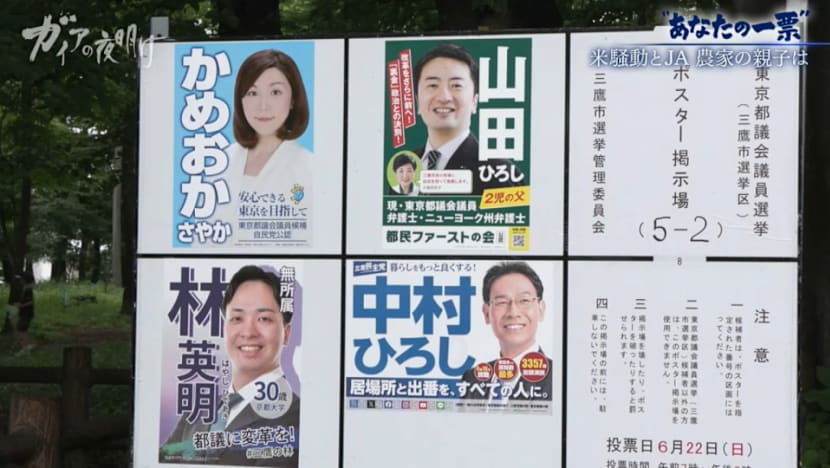Gaia Series 104: Your Vote
On Japan’s smallest village and in Tokyo’s suburbs, voters wrestle with loyalty, legacy and the fight to be heard in a crucial local election.


This audio is generated by an AI tool.
In a remote Tokyo island and on Mitaka’s farms, voters reflect deep questions about voice, values and the cost of every ballot.
On a volcanic island 350km south of Tokyo, where ferry cancellations are as common as fishing nets, 126 eligible voters cast their ballots in Japan’s Tokyo Metropolitan Assembly election. Aogashima, with its striking double caldera and population of 157, is the country’s smallest village and, improbably, under Tokyo’s jurisdiction. Yet, in this year’s election, the island becomes a microcosm of Japan’s wider political reckoning.
Aogashima’s turnout of 82.54 per cent dwarfed the city’s overall rate of 47.59 per cent. This is part of a legacy shaped by disenfranchisement. Until 1956, residents here had no right to vote due to the absence of transport and communication infrastructure. “That is why here on Aogashima, people believe you must vote if you want your voice heard,” says Mayor Hiroshi Sasaki. The only ballot box on the island serves not just a practical purpose, but stands as a symbol of hard-won rights.
But the island’s political loyalties face new challenges. Historically a conservative stronghold, Aogashima has long supported the Liberal Democratic Party (LDP). That loyalty came under strain after incumbent LDP assemblyman Masahiko Miyake was caught in a slush fund scandal involving 3.32 million yen (S$30,000). Despite disappointment, local leaders like village assembly chair Tadashi Kikuchi continue to support him. “They simply do not understand how harsh life is on the islands,” he says. “It costs money. In Tokyo, people’s lives are not affected by such things.”
Sho Ito, a 34-year-old island native representing the Democratic Party for the People, entered the race and visited the island during the campaign. He had only three hours before bad weather forced him to leave. Despite the brief visit, his presence mattered. He was the only candidate to show up in person. “I am an islander, born and raised here. I want to fight that,” he says at a rally attended by seven residents. His supporter, YouTuber Kae Sasaki, added, “If we leave everything to others, nothing changes. The island declines instead.”
That sense of decline goes beyond politics. Aogashima’s school faced closure three years ago when there were no students left. Arisa Yamada, 63, who makes the island’s Hingya Salt using geothermal steam, has taken in exchange students to keep the school running. “Middle school is not just a place to study, but the island's final stage of growth,” she says. The village recently adopted the programme officially, recognising that its survival depends on young people.
Meanwhile in Mitaka, a commuter town on Tokyo’s outskirts with 190,000 residents, voters are also weighing the future. At Okada Farm, 37-year-old Keita Okada plants edamame seedlings and reflects on his life transformation. Once a footballer, he now runs a 300-year-old family farm with his mentor and father-in-law Genji, 76. “Soil preparation, that is the most important thing,” Genji says. “If you do not value it... it will end up empty inside, just like people.”
Farming in Tokyo’s suburbs is sustained by public funding. The Okadas received subsidies worth 3.6 million yen to build a greenhouse and an unmanned vegetable stand. These funds were part of the Urban Farming Revitalisation Project, a programme tied to the Tokyo budget. “Without subsidies, large projects like this are impossible,” says Genji.
Their political interest centres on Sayaka Kameoka, a 46-year-old Liberal Democrat whose grandfather served as Minister of Agriculture. She received an endorsement from JA-affiliated groups, historically a powerful bloc in agricultural policy. However, the LDP’s relationship with the Japan Agricultural Cooperative (JA) has frayed. Minister Shinjiro Koizumi bypassed JA in distributing rice reserves, which caused backlash. “They have ripped Japan Agricultural Cooperative to pieces,” Genji says.
While the Okadas support Kameoka, Keita himself is undecided. “Now, my work is farming,” he says. “But I must also consider child-rearing issues, and eventually, care for my parents. How can we live better lives, with positive influence on our daily lives? That is what I think about. So my vote will reflect that.”
Kameoka ultimately fails to win a seat. The LDP suffers its worst defeat in the Tokyo assembly elections. Constitutional Democrats and Tokyo Citizens First make the largest gains. On Aogashima, Miyake still wins with 53 votes, while Ito receives 36.
Elsewhere, in Tokyo’s Okunitama Shrine, Chiaki Saito, chair of the Japanese Trade Union Confederation (Rengo Tokyo), rallies support for the opposition. Rengo once had 6.8 million members, but its influence is fading. The group has lost one million members in the past 30 years, and young union voters now divide their support across the political spectrum. In one union poll, young members even wrote “LDP” as their preferred party. A satirical video by Rengo, viewed 18,000 times in a week, warned that failing to vote could lead to military service and consumption tax hikes. “It is because you did not vote,” the characters say. “It is all your fault.”
As election day ends, the message lingers. “That precious single vote of yours — who will you give it to?” the narrator asks. Each Tokyo voter may be just one among millions, but as one guide calculates, with a nine trillion yen city budget divided across 11.5 million voters, each vote influences three million yen. “If it were cash, no one would waste it, would they?”
On Aogashima, they certainly don’t. Voting there is not just a civic duty, but a form of stewardship. Whether protecting schools, farmland or island life, residents know their future depends on their voice being counted.












